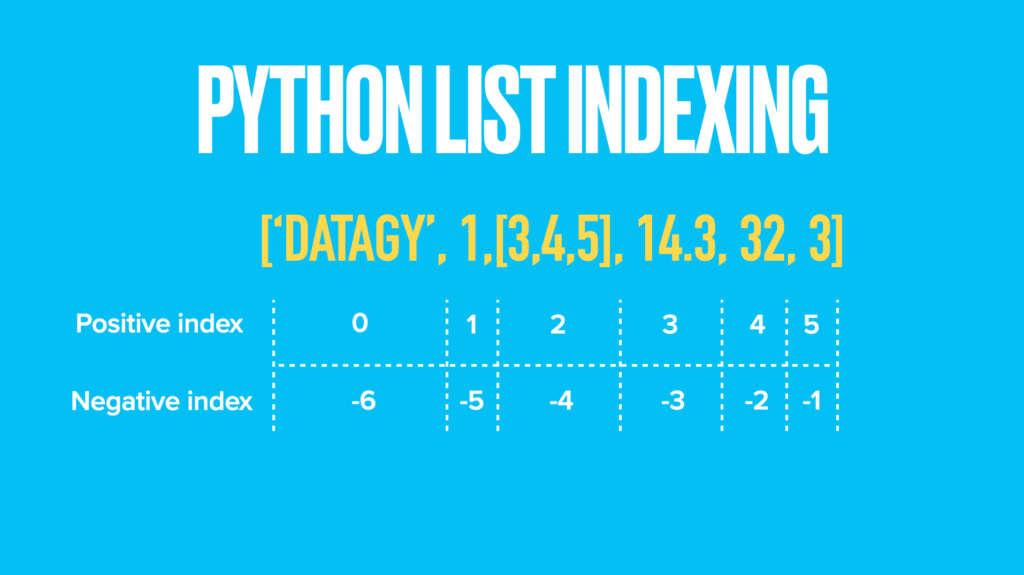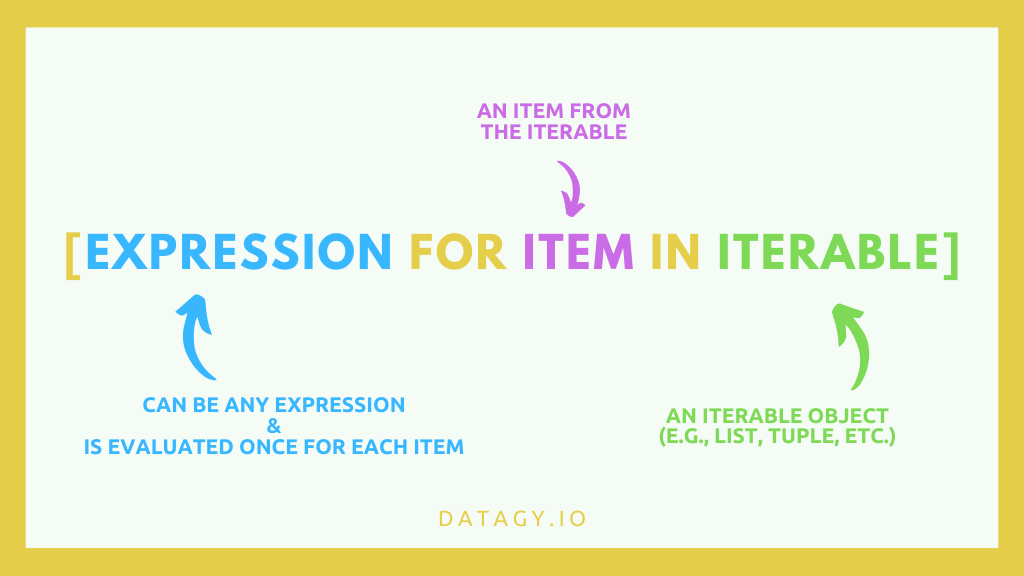In this tutorial, you’ll learn how to use Python to split a list, including how to split it in half and into n equal-sized chunks. You’ll learn how to split a Python list into chunks of size n, meaning that you’ll return lists that each contain n (or fewer if there are none left) items. Knowing how to work with lists in Python is an important skill to learn.
By the end of this tutorial, you’ll have learned:
- How to split a list in half in Python
- How to split a list into chunks in Python
- How to split a list at a particular index position in Python
- How to use NumPy to split a list in Python
The Quick Answer: Use List Indexing to Split a List in Python

Table of Contents
How to Access a Python List by Its Index
One of the many wonderful properties of lists is that they are ordered. This means that we can access an item, or a range of items, by its index. Let’s see how Python list indices work:

We can see here that Python lists have both a positive index as well as a negative index. A positive index begins at position 0, meaning the first item. A negative list index begins at -1, allowing you to retrieve the last item of a list.
Similarly, you can access ranges of data within a list using list slicing. This can be done by using the : colon character, which allows you to select items from a specific position up to a specific position.
How to Split a Python List in Half
You can easily split a Python list in half using list indexing. As you learned above, you can select multiple items in a list using list slicing. Let’s see how we can use list slicing to split a list in half:
# Split a List in Half with Python List Slicing
a_list = [1, 2, 3, 4, 5, 6, 7, 8, 9, 10]
half_length = len(a_list) // 2
first_half, second_half = a_list[:half_length], a_list[half_length:]
print(f'{first_half=}')
print(f'{second_half=}')
# Returns:
# first_half=[1, 2, 3, 4, 5]
# second_half=[6, 7, 8, 9, 10]Let’s break down what we did in the code above:
- We created a list
a_list, which contains ten different items - We then created an integer variable,
half_length, which is the result of dividing the length of the list by two using integer division - We then assigned variables,
first_halfandsecond_half, which sliced the lists up to and from the half variable
In the following section, you’ll learn how to split a list into different sized chunks in Python.
Split Lists into Chunks Using a For-Loop
For-loops in Python are an incredibly useful tool to use. They make a lot of Python methods easy to implement, as well as easy to understand. For this reason, let’s start off by using a for-loop to split our list into different chunks.
One of the ways you can split a list is into n different chunks. Let’s see how we can accomplish this by using a for loop:
# Split a Python List into Chunks using For Loops
a_list = [1, 2, 3, 4, 5, 6, 7, 8, 9, 10, 11]
chunked_list = list()
chunk_size = 3
for i in range(0, len(a_list), chunk_size):
chunked_list.append(a_list[i:i+chunk_size])
print(chunked_list)
# Returns: [[1, 2, 3], [4, 5, 6], [7, 8, 9], [10, 11]]Let’s take a look at what we’ve done here:
- We instantiate two lists:
a_list, which contains the items of our original list, andchunked_list, which is empty - We also declare a variable,
chunk_size, which we’ve set to three, to indicate that we want to split our list into chunks of size 3 - We then loop over our list using the range function. What we’ve done here is created items from 0, through to the size of our list, iterating at our chunk size. For example, our range function would read
range(0, 11, 3), meaning that we’d loop over using items0,3,6,9. - We then index our list from
i:i+chunk_size, meaning the first loop would be0:3, then3:6, etc. - These indexed lists are appended to our list
We can see that this is a fairly straightforward way of breaking a Python list into chunks. Next, you’ll learn how to do accomplish this using Python list comprehensions.
Split Python Lists into Chunks Using a List Comprehension
In many cases, Python for-loops can be rewritten in a more Pythonic way by writing them as one-liners called list comprehensions. List comprehensions in Python have a number of useful benefits over for-loops, including not having to instantiate an empty list first, and not having to break your for-loop over multiple lines.
Let’s see how we can write a Python list comprehension to break a list into chunks:
# Split a Python List into Chunks using list comprehensions
our_list = [1, 2, 3, 4, 5, 6, 7, 8, 9, 10, 11]
chunk_size = 3
chunked_list = [our_list[i:i+chunk_size] for i in range(0, len(our_list), chunk_size)]
print(chunked_list)
# Returns: [[1, 2, 3], [4, 5, 6], [7, 8, 9], [10, 11]]Before we break down this code, let’s see what the basic syntax of a Python list comprehension looks like:

Now let’s break down our code to see how it works:
- We declare a variable
chunk_sizeto determine how big we want our chunked lists to be - For our list comprehensions expression, we index our list based on the ith to the i+chunk_sizeth position
- We use this expression to iterate over every item in the output of the
range()object that’s created based onrange(0, len(our_list), chunk_size, which in this case would be0,3,6,9
While this approach is a little faster to type, whether or not it is more readable than a for-loop, is up for discussion. Let’s learn how to split our Python lists into chunks using numpy.
Want to learn more? Check out my in-depth tutorial about Python list comprehensions by clicking here!
Split Lists into Chunks Using NumPy
Numpy is an amazing Python library that makes mathematical operations significantly easier. That being said, NumPy also works with a list-like object, called NumPy arrays, that make working with lists much easier. These NumPy arrays come packaged with lots of different methods to manipulate your arrays.
It’s important to note that this method will only work with numeric values.
In this section of the tutorial, we’ll use the NumPy array_split() function to split our Python list into chunks. This function allows you to split an array into a set number of arrays.
Let’s see how we can use NumPy to split our list into 3 separate chunks:
# Split a Python List into Chunks using numpy
import numpy as np
a_list = [1, 2, 3, 4, 5, 6, 7, 8, 9]
our_array = np.array(a_list)
chunked_arrays = np.array_split(our_array, 3)
chunked_list = [list(array) for array in chunked_arrays]
print(chunked_list)
# Returns: [[1, 2, 3], [4, 5, 6], [7, 8, 9]]This is a fairly long way of doing things, and we can definitely cut it down a little bit. Let’s see how that can be done:
chunked_list = [list(array) for array in np.array_split(np.array(our_list), 3)]
print(chunked_list)
# Returns: [[1, 2, 3], [4, 5, 6], [7, 8, 9]]Let’s break this down a little bit:
- We turn our list into a Numpy array
- We split our array into n number of arrays using the
np.array_split()function - Finally, we use a list comprehension to turn all the arrays in our list of arrays back into lists.
Want to learn more about division in Python? Check out my tutorial on how to use floored integer division and float division in Python in this tutorial here.
Split Lists into Chunks Using Itertools
Let’s see how we can use itertools library to split a list into chunks. In particular, we can use the zip_longest function to accomplish this.
Let’s see how we can do this:
# Split a Python List into Chunks using itertools
from itertools import zip_longest
our_list = [1, 2, 3, 4, 5, 6, 7, 8, 9, 10, 11]
chunk_size = 3
chunked_list = list(zip_longest(*[iter(our_list)]*chunk_size, fillvalue=''))
print(chunked_list)
# Returns: [(1, 2, 3), (4, 5, 6), (7, 8, 9), (10, 11, '')]
chunked_list = [list(item) for item in list(zip_longest(*[iter(our_list)]*chunk_size, fillvalue=''))]
print(chunked_list)
# Returns: [[1, 2, 3], [4, 5, 6], [7, 8, 9], [10, 11]]We can see here that we can have a relatively simple implementation that returns a list of tuples. Notice one of the things that are done here is split the list into chunks of size n, rather than into n chunks.
Frequently Asked Questions
The best way to split a Python list is to use list indexing, as it gives you huge amounts of flexibility.
The NumPy array_split() function allows you to easily split arrays into a given number of arrays. However, the function only works with numeric values (as NumPy arrays can only contain numeric values).
Conclusion
In this post, you learned how to split a Python list into chunks. You learned how to accomplish splitting a Python list into chunks of size n or into n number chunks. You learned how to do this using a for-loop, using list comprehensions, NumPy and itertools.
Additional Resources
To learn more about related topics, check out the tutorials below:
- Python Lists: A Complete Overview
- Python List sort(): An In-Depth Guide to Sorting Lists
- Python: Find List Index of All Occurences of an Element
- To learn more about the
numpy.array_splitmethod, check out the official documentation here.

